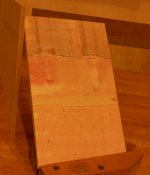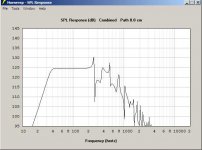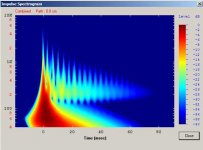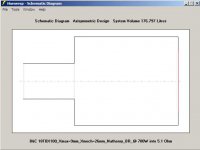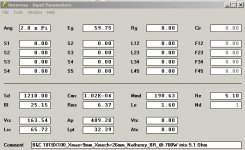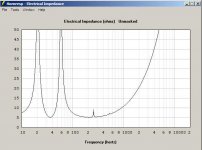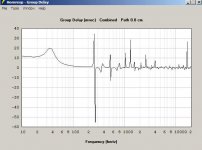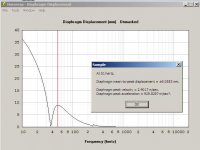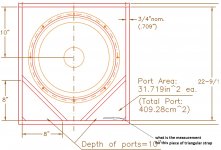Sreten
Can you post a spl response chart for the higher tunning speaker.
Hi,
Not easily now. Attached is the lower tuning. Basically the peak at 30Hz
moves up to to 40Hz with the lowest dip being 122dB with less of a dip.
so its around 124dB at 40Hz with the higher tuning.
For the lower tuning shown you can see SPL drops severely below 23Hz,
the higher tuning the same from 30Hz. Note that with 2 cabinets per side
maximum levels increase by 6dB, with the higher tuning and two cabinets
maximum levels are about 128dB, and you can compare to the upper units.
rgds, sreten.
Attachments
Last edited:
My 2 cents: I did like the 6" round PVC port plan; that would be the easiest to re-tune and experiment with.
Please don't disregard the high grade Baltic Birch Plywood advice; it really would be a shame to put $600 of woofers in C**p HD/Lowes birch ply; that grade is for diy home projects, not a fine speaker project like this.
Please don't disregard the high grade Baltic Birch Plywood advice; it really would be a shame to put $600 of woofers in C**p HD/Lowes birch ply; that grade is for diy home projects, not a fine speaker project like this.
What's in there?
I removed the top layer of a typ piece of plywood; see the voids? The Baltic Birch (on left) is much more dense/heavy and has many more ply's (layers) than typ HD/Lowes plywood - it is worth the effort to track it down.
I removed the top layer of a typ piece of plywood; see the voids? The Baltic Birch (on left) is much more dense/heavy and has many more ply's (layers) than typ HD/Lowes plywood - it is worth the effort to track it down.
Attachments
Last edited:
I removed the top layer of a typ piece of plywood;[special=]%[/special] see the voids? The Baltic Birch (on left) is much more dense/heavy and has many more ply's (layers) than typ HD/Lowes plywood - it is worth the effort to track it down.
That is not good thanks for telling me.
Oliver, we decide to go with your drawing from post#72. Can you please post all the info and dimension for building the speaker box
Thanks
Thanks
Hi Nathenry,
I'll try to get to this today, and I'll take a closer look at the port size and the box depth/volume to incorporate sreten's good advice as to the tuning.
Have you found a source for wood yet? It would be good to know the basic dimensions of your material. If available baltic birch (BB) is the obvious choice, but a lot of fine enclosures have been build with other high quality voidfree (that's the key word here) plywoods. Anyway I'll try to add some notes as to corner cleats and braces.
Regards,
I'll try to get to this today, and I'll take a closer look at the port size and the box depth/volume to incorporate sreten's good advice as to the tuning.
Have you found a source for wood yet? It would be good to know the basic dimensions of your material. If available baltic birch (BB) is the obvious choice, but a lot of fine enclosures have been build with other high quality voidfree (that's the key word here) plywoods. Anyway I'll try to add some notes as to corner cleats and braces.
Regards,
Oliver
One of my friend said he knows where to get some good quality 4x8 plywood through a carpenter buddy of his.
One of my friend said he knows where to get some good quality 4x8 plywood through a carpenter buddy of his.
Hi Nathenry,
Got it, 3/4" x 4' x 8' plywood (voidfree!).
Regards,
Ok
Hi Nathenry,
Took a little longer than I thought it would. I moved the driver mounting baffle back the thickness of the plywood (the second front baffle will not fit on the 4x8 board unless it would be assembled from scrap pieces; but, this will give you a much stronger two piece front baffle, see: drawings), and recalculated the volume, the duct (port) dimensions, etc... Then the drawing exceeded the upload limit, and I had to break it into four parts...
Let me know if you need any additional information or prints. You know, we'll want to see pictures of your progress?
Regards,
Took a little longer than I thought it would. I moved the driver mounting baffle back the thickness of the plywood (the second front baffle will not fit on the 4x8 board unless it would be assembled from scrap pieces; but, this will give you a much stronger two piece front baffle, see: drawings), and recalculated the volume, the duct (port) dimensions, etc... Then the drawing exceeded the upload limit, and I had to break it into four parts...
Let me know if you need any additional information or prints. You know, we'll want to see pictures of your progress?
Regards,
Attachments
Last edited:
Oliver
We want to thank you and everyone on this forum who chipped in to help out on this project.I must say i did learn somethings. it is important to think before you design and know what you want before you ask for help. LOL
I will take some pic to post.
How much watts can one speaker box take?
what is the hi pass and low pass setting?
Thanks
We want to thank you and everyone on this forum who chipped in to help out on this project.I must say i did learn somethings. it is important to think before you design and know what you want before you ask for help. LOL
I will take some pic to post.
How much watts can one speaker box take?
what is the hi pass and low pass setting?
Thanks
Hi Nathenry,
Post #95: "...How much watts can one speaker box take?...what is the hi pass and low pass setting?"
You do know how to open up a can of worms, dont you? 🙂
Anyway:
The data sheet says: AES power handling=1200W, Xmax=9mm, Xvar=11mm. It also gives limited maximum SPL/Watts data at the bottom below the factory box suggestion graph: excursion limit 120.3dB/340.4W, and thermal limit 125.8dB/1200.0W.
I'll attach the Hornresp screens for the condition 700W into 5.1 Ohm. With this input power the driver reaches Xmax @ 51Hz.
At 1000W/5.1 Ohm we get an excursion of 10.82mm @ 51Hz, still within thermal limits, and within Xvar=11mm. At that input level Hornresp shows an excursion of 14.98mm @ 30Hz, which is still well below the Xmech=26mm (Xmech: mechanical limit of motion, i.e.: before damage). I cannot recall where I found the Xmech.
Assuming, that the manufacturers AES power rating is correct, using this design with a power amplifier up to 1000W seems reasonable, provided a high pass filter is used to reduce the power input at the low end of the spectrum. I would recommend a fourth order filter with a corner frequency of 25-30Hz (or a second order filter - 30-35Hz). Others may have more in depth suggestions.
Looking at the spectrogram, operation up to 200Hz seems possible, cutting it out a little lower would be better, but that depends on the combined system as does the filter slope.
Regards,
Post #95: "...How much watts can one speaker box take?...what is the hi pass and low pass setting?"
You do know how to open up a can of worms, dont you? 🙂
Anyway:
The data sheet says: AES power handling=1200W, Xmax=9mm, Xvar=11mm. It also gives limited maximum SPL/Watts data at the bottom below the factory box suggestion graph: excursion limit 120.3dB/340.4W, and thermal limit 125.8dB/1200.0W.
I'll attach the Hornresp screens for the condition 700W into 5.1 Ohm. With this input power the driver reaches Xmax @ 51Hz.
At 1000W/5.1 Ohm we get an excursion of 10.82mm @ 51Hz, still within thermal limits, and within Xvar=11mm. At that input level Hornresp shows an excursion of 14.98mm @ 30Hz, which is still well below the Xmech=26mm (Xmech: mechanical limit of motion, i.e.: before damage). I cannot recall where I found the Xmech.
Assuming, that the manufacturers AES power rating is correct, using this design with a power amplifier up to 1000W seems reasonable, provided a high pass filter is used to reduce the power input at the low end of the spectrum. I would recommend a fourth order filter with a corner frequency of 25-30Hz (or a second order filter - 30-35Hz). Others may have more in depth suggestions.
Looking at the spectrogram, operation up to 200Hz seems possible, cutting it out a little lower would be better, but that depends on the combined system as does the filter slope.
Regards,
Attachments
Oliver
That what I get for reading and trying to understand how speaker operators. So we could get this project done for my husband.
Thanks for the info
That what I get for reading and trying to understand how speaker operators. So we could get this project done for my husband.
Thanks for the info
- Status
- Not open for further replies.
- Home
- Loudspeakers
- Subwoofers
- Bass for my soldier
